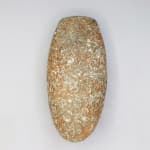Egyptian Prehistoric Hand-Axe, 8500 BC - 6500 BC
Granite
13.6 x 6.2 x 5.8 cm
5 3/8 x 2 1/2 x 2 1/4 in
5 3/8 x 2 1/2 x 2 1/4 in
CC.68
Further images
-
(View a larger image of thumbnail 1
)

-
(View a larger image of thumbnail 2
)

-
(View a larger image of thumbnail 3
)

-
(View a larger image of thumbnail 4
)

-
(View a larger image of thumbnail 5
)

-
(View a larger image of thumbnail 6
)

-
(View a larger image of thumbnail 7
)

-
(View a larger image of thumbnail 8
)

-
(View a larger image of thumbnail 9
)

-
(View a larger image of thumbnail 10
)

-
(View a larger image of thumbnail 11
)

The polished stone axe is considered the emblematic tool of the Neolithic. They are considered by many archaeologists to be the primary indicator of a Neolithic economy. Polished stone axes...
The polished stone axe is considered the emblematic tool of the Neolithic. They are considered by many archaeologists to be the primary indicator of a Neolithic economy. Polished stone axes were considered the accumulation of all the knowledge built through centuries of creating flint knapped axes; it was also a social development, reflecting a change in the social organisation of Neolithic peoples. With this technological change, it was suddenly possible for Neolithic to create quite complex wooden carpentry, including boats and looms, though there is no evidence that such inventions occurred. Why the creation of the polished hand-axe did not also precipitate a major technological revolution is unknown.
With an elegant, ovoid shape, this hand-axe is as aesthetically designed as it is practically. One hand can mostly reach around the axe, and the curved end is designed to be held by a second hand, to increase the downward force on the ‘blade’ end. The cutting edge itself is thin and squared-off, designed both for striking and cutting. There are signs of wear on the cutting edge. The axe is perfectly designed with the user in mind; its weight, balance, and shape indicate a craftsman of incredible skill and experience. This tool had multiple purposes; it could be used by the women as a pestle and blade to grind and process food, but was also used by the menfolk in hunting and woodworking.
This item is exceptionally finely-crafted, and this has led some to suggest that such hand-axes were not intended to be used, but were instead created for ritual or social purposes. They may have been important status-symbols for the leaders of Neolithic society, or prestige items that indicated the wealth of the owner. They may also have been dedications to the gods or spirits that animated Neolithic life. Whatever their purpose, they certainly became a commodity, and were traded relatively large distances across Europe and North Africa. It seems that larger axes travelled greater distances, and were valued more highly.
With an elegant, ovoid shape, this hand-axe is as aesthetically designed as it is practically. One hand can mostly reach around the axe, and the curved end is designed to be held by a second hand, to increase the downward force on the ‘blade’ end. The cutting edge itself is thin and squared-off, designed both for striking and cutting. There are signs of wear on the cutting edge. The axe is perfectly designed with the user in mind; its weight, balance, and shape indicate a craftsman of incredible skill and experience. This tool had multiple purposes; it could be used by the women as a pestle and blade to grind and process food, but was also used by the menfolk in hunting and woodworking.
This item is exceptionally finely-crafted, and this has led some to suggest that such hand-axes were not intended to be used, but were instead created for ritual or social purposes. They may have been important status-symbols for the leaders of Neolithic society, or prestige items that indicated the wealth of the owner. They may also have been dedications to the gods or spirits that animated Neolithic life. Whatever their purpose, they certainly became a commodity, and were traded relatively large distances across Europe and North Africa. It seems that larger axes travelled greater distances, and were valued more highly.










